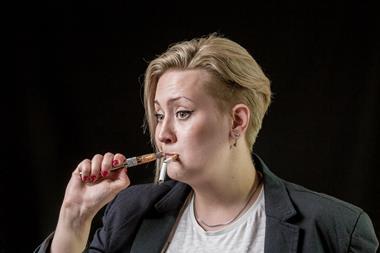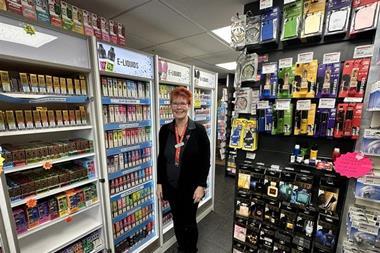With all the legislative issues affecting the tobacco market, it could be easy to lose sight of the category’s importance to the forecourt sector. And important it is. After all it’s not that long ago that the forecourt ’shop’ was more of a kiosk selling cigarettes and a bit of confectionery. Today many of those ’shops’ have developed into full-blown convenience stores yet cigarettes and other tobacco products can still account for up to a third of sales.
Last year, according to RAL data, almost £1.5bn-worth of tobacco items were sold in UK forecourts. Indeed so important is the forecourt channel to the tobacco category that it accounted for 11.5% of total UK cigarette sales in 2007, 10.5% of roll your own tobacco sales, 9% of rolling paper sales, and 11.7% of miniature cigar sales.
== Cigarettes ==
Lambert & Butler King Size (L&B KS) is still the UK’s best selling cigarette brand and it’s a position it has held for 10 years. It now accounts for over 13% of total duty paid cigarette sales and generates nearly £1.5bn of turnover for retailers.
In forecourts too L&B KS is number one with a 14.8% share of sales, amounting to £194.6m in 2007. The L&B range is currently available in a limited-edition pack printed on special holographic board.
L&B is classed as a ’standard’ priced cigarette and despite its popularity in forecourts, it is the premium-priced cigarette sector that actually performs best. Premium-priced cigarettes include Marlboro Gold, Benson & Hedges Gold and Silk Cut Purple.
Jeremy Blackburn, head of communications at Gallaher, explains: "Premium brands accounted for nearly 42% of cigarette sales in forecourts last year compared to just 34% of sales across the total UK cigarette market."
Marlboro Gold King Size is the best-selling premium brand in forecourts with 10.6% of cigarette sales compared to 7% across the total market.
Next is Benson & Hedges Gold King Size, which accounts for 8.9% of cigarette sales in forecourts versus 6% in the total market. And it’s a similar story with Silk Cut Purple and Embassy Number 1 - both of which sell better in forecourts than in other trade sectors.
Like Lambert & Butler, Benson & Hedges and Silk Cut are currently available in limited-edition packs which Blackburn says emphasises the premium nature of the product. He also believes they will create "excitement and extra stand out" on shelf.
The four designs across the Benson & Hedges range incorporate a molten gold theme with ’golden nuggets’ of information printed on the side of the pack, which help to emphasise the brand’s quality.
The Silk Cut Purple and Silk Cut Silver designs include a leaf emblem on the side of the pack to highlight the smooth premium quality of the brand and support Silk Cut’s position as the UK’s number one low tar cigarette.
Blackburn says: "Together Benson & Hedges Gold and Silk Cut represent over a third of all premium cigarettes sold in the UK. It is important for forecourt retailers to remember that this sector commands a significant proportion of the cigarette market and is also the most profitable."
Another Gallaher premium brand with new-look packs, but this time on a permanent basis, is Camel.
The new packaging includes an embossed logo and refreshed imagery to emphasise the brand’s premium positioning in the UK tobacco market.
Camel is the fifth largest cigarette brand in the world and it continues to grow its share in the UK. Blackburn says Camel Subtle is particularly popular with style-conscious adult smokers in urban areas and as such he reckons the brand has great growth potential.
Blackburn explains that for retailers trading in the major conurbations, the popularity of premium cigarettes is very evident but adds: "With the more local outlets, say where the village shop has closed and the forecourt shop has taken its place, regionality comes more into play. We see Mayfair doing really well in Scotland for instance while B&H Gold does well in the South East and the West Midlands."
When it comes to merchandising and display, Blackburn says out-of-stocks are still a problem. "A lot of forecourts rely on deliveries and they get into order patterns which can be rigid and they can run out if they’re hit by good weather and an influx of tourists, for example. I’d always advise retailers to be aware of local events and holiday times, to make sure they are stocked up. It is important to remember that smokers are brand loyal and retailers will miss out on sales if their customers can’t see the brands they want."
He also advises retailers to keep their displays tidy and to make sure their staff are well trained. "You need to train staff about things like pictorial health warnings - making them aware that stock rotation is necessary. And train them to challenge ID - especially at holiday times when there are likely to be new faces around."
== Roll your own tobacco ==
Iain Watkins, trade communications manager at Imperial Tobacco, says the UK roll your own (RYO) tobacco market continues to show remarkable resilience in the fight-back against the twin threats of smuggling and counterfeiting.
"UK duty paid RYO volumes sold through retail outlets grew steadily throughout 2007 to over 3,500 tonnes - up 7.4% on 2006. The sales value of the RYO market also grew last year - by over 12% to reach £767m.
According to RAL data, forecourts accounted for 10.5% of all RYO tobacco sales in 2007. Best seller was Golden Virginia which accounts for 46% of sales across all UK outlets but fares even better in forecourts where it accounts for 56% of sales.
Number two brand is Amber Leaf with a 17% share of sales in forecourts. Gallaher’s Blackburn says it does well because packs come complete with papers.
Imperial launched Gold Leaf RYO tobacco into the lower-priced sector last year and the company says it had an immediate impact, gaining a 2.5% share of sales in independent outlets within six months of launch.
Blackburn reckons there is still an opportunity for upweighted purchases in RYO tobacco. He says retailers should not just be stocking the 12.5g pouches - they need the 25g packs too. If you look at the sales data, 58% of forecourts’ RYO sales are from 12.5g pouches; 32% from 25g; and 8% from 50g (with the remaining 2% coming from other pack sizes). However when you compare these figures to data from the multiple grocers you can see there is demand for larger pack sizes. In multiple grocers 37% of sales come from 50g packs; 33.5% from 25g; and just 29% from 12.5g pouches.
Meanwhile Imperial’s Watkins is keen to remind retailers about the ’dualist’ trend - where smokers switch between factory-made cigarettes and rolling their own. He says it is still an important factor in the market: "Over four million adult smokers currently ’dual’ between the cigarette and RYO segments.
"This has seen the continued evolution of the profile of a typical roll-your-own smoker. The market is now more acceptable and accessible to adult females aged 18 to 34 years while remaining popular with adult males from all social classes."
== Cigars ==
Remember the old charity tagline - ’A dog is for life, not just for Christmas’? Well the same seems to be true of cigars. Gallaher’s Blackburn says retailers should stock them all year round. Yes, of course a lot of people smoke them at Christmas, but there are also regular year-round cigar smokers too and those who smoke them at other celebratory times.
That said, the number of adult cigar smokers has remained relatively static for the past five years but manufacturers say the cigar segment continues to be a vital element of the UK tobacco category. Indeed smokers spent almost £435m on cigars last year.
The Hamlet house is king of cigars. According to AC Nielsen figures it accounts for 46.6% of the forecourt market. Within that, Hamlet fives account for 24.5% of sales and Hamlet Miniatures 17.5%. In the total market, the Hamlet house accounts for 40% of sales so Hamlet is another brand in which forecourts seriously over-trade.
The cigar market is clearly segmented into three size sectors - miniature, small and large. Growth in the miniature sector has slowed in the past few years, however the sector is still forecast to account for over 50% of cigar sales by 2010.
James Higgs, head of commercial marketing at Henri Wintermans UK, reckons the reason for miniatures’ popularity is that it’s easier for time poor/venue restricted smokers to smoke them rather than small-size cigars."
He adds: "Furthermore, adult smokers are increasingly ’dualling’ between cigarettes and cigars and when cigarette smokers do this, they typically choose a miniature cigar.
In addition, many miniature cigars are being bought on impulse, and to capitalise on this trend Henri Wintermans has brought out Café Crème Blue in a fives tin to assist consumers who want to try miniatures."
Higgs continues: "We feel the stylish tins reflect the brand’s worldwide status and heritage, and help make the Café Crème range absolutely integral to every retailer’s tobacco unit."
According to AC Nielsen, the Café Crème range is now the market-leading brand in the miniature cigar sector, with around 60% of total sales.
And, according to RAL, Café Crème and Café Crème Blue are the only two cigar brands in the top five to have recorded significant growth in share of total cigar sales in forecourts over the past 12 months - up around 5% and 11% respectively. In forecourts, Café Crème Blue is the number two cigar brand behind Hamlet 5s.
Another decent seller in forecourts is the Henri Wintermans Half Corona. Higgs comments: "While the UK cigar market is declining by around 15% annually, sales of our brands such as the Half Corona continue to grow. Retailers should therefore ensure that their shelves are always fully stocked up with these top-selling brands."
He also advises retailers to:
? Stock a good range of quality imported cigars as they stimulate the tobacco category and drive incremental sales and impulse purchases.
? Brand-block imported cigars and also double-face the miniature segment leaders.
? Remember that larger imported cigars like the Half Corona and Corona De Luxe drive incremental sales and provide excellent profit margins.
? Avoid out-of-stocks as 33% of cigar smokers will immediately go elsewhere if they can’t find what they want.
== Rolling papers ==
Despite the growth in the RYO tobacco segment, rolling paper sales have not grown and sales actually declined last year. However rolling papers is still a sizable market - worth nearly £110m.
Rizla is the clear market leader with Rizla Regular Green the best-selling rolling paper in the UK - accounting for over 49% of sales.
Meanwhile Swedish Match reports that almost a quarter of its Swan Combi sales are through forecourts. Swan Combi is no wider than a packet of papers but includes 50 Swan Extra Slim filters alongside a pack of 50 Swan green papers.
Andrew Hardie, marketing manager at Swedish Match, says the product’s popularity comes from the fact that it is a ’two-in-one’ and reduces the number of packs that a RYO smoker has to carry.
He continues: "With 125 years of heritage in the category, Swan has strong visibility on shelf and delivers good margins into the till. Forecourt traders can use Swan as the signpost to the category."
The company launched Swan Smooth at the recent Pro-Retail show. Hardie says it is the first ever carbon cavity Pop-A-Tip filter, designed to offer a smoother smoke.
"Developed following intensive research among RYO smokers, Swan Smooth comprises an activated carbon filter providing enhanced filtration for a more satisfying roll-up."
The Swan brand has also recently become an associate sponsor of Bennetts British Superbikes (BSB).
This means Swan gets high-profile branding track-side and also on the winner’s podium.
A highlight of each BSB weekend will be the Swan Combi 50 - Roll for Pole. Taking place the day before the main race, this will see riders go head to head against the clock.
The fastest rider will then take the coveted ’pole position’ on the starting grid in the following day’s main race, with the slowest rider taking the final position on the grid.
----
=== Convenience smokers ===
Data from Him’s 2008 Convenience Tracking Programme reveals that:
* 35% of shoppers surveyed were smokers
* 16% of shoppers had bought cigarettes ’here at this store today’
* 1% bought RYO tobacco
* 10% of all those shoppers purchasing more than one item said their main reason for visiting ’this store today’ was to buy cigarettes/tobacco products
* Only 1% failed to buy the cigarettes they intended to buy
* When it came to cigarette pack size - 69% bought a pack of 20; 30% bought a pack of 10; and 2% bought a pack of 40
* 69% said they believe ’this store’ restricted the sale of cigarettes and alcohol to under-age shoppers.
Source: CTP average figures from convenience stores including forecourts
----
=== Top 10 cigarettes in forecourts ===
1. Lambert & Butler King Size
2. Marlboro Gold King Size
3. Benson & Hedges Gold King Size
4. Mayfair King Size
5. Benson & Hedges Silver King Size
6. Richmond King Size
7. Silk Cut Purple King Size
8. Richmond Superkings
9. Royals King Size Red
10. Embassy Number 1
Source: RAL
----
=== tobacco at the point of sale - Make sure your views are heard ===
As you read this, the government, as part of its Cancer Reform Strategy, is considering proposals to help reduce smoking among teenagers. These will most likely include the restriction of tobacco product displays at the point of sale; a ban on packs of cigarettes containing less than 20; and a ban on tobacco vending machines.
The Tobacco Manufacturers’ Association (TMA), representing the UK tobacco industry, believes that smoking is a matter of informed adult choice and that children should not smoke and should be discouraged from doing so. It agrees that the industry should be appropriately regulated, striking a balance between "pursuing public health policy objectives and at the same time allowing adults the freedom of choice to smoke". The TMA believes regulation should be fair and should avoid unnecessarily burdening retailers and small businesses in particular.
When it comes to the restriction of tobacco product displays at the point of sale, the TMA is against this and states: "Display of product is essential to enable adult consumers to make an informed choice based on availability, price and brand from the wide range of tobacco products on the market. It is necessary for fair and undistorted competition between manufacturers and between retailers. It is also essential to the efficiency of the retailing process, which is increasingly dependent on speeding up transaction times and reducing the need for extended verbal communication."
The TMA’s statement continues: "Product display at point of sale, rather than elsewhere on the premises, is also necessary for security and retail efficiency reasons as tobacco is a high-value FMCG product. It is the most requested FMCG product with approximately 11m smokers in the UK regularly buying tobacco products. In addition, concealing tobacco products from view makes it easier for traders of smuggled product to blend it into the legal supply chain, and could pose further challenges to the enforcement effort against such traders."
Gallaher’s head of communications, Jeremy Blackburn, is concerned that if smokers can’t see product in store, they might find another source of supply, possibly someone selling smuggled or counterfeit product in pubs or on street corners.
He comments: "The more you ban something the more some people will want it - it’s the forbidden fruit theory. And street-corner merchants will have no qualms selling cigarettes to anyone; they will not be asking for ID. What we have to remember is that the vast majority of retailers use and challenge for ID - it’s an effective way of tackling the under-age problem." Blackburn also worries about retail efficiency, saying that queues could form as retailers fumble under the counter to find the tobacco products - "in a busy forecourt this could mean smokers and even non-smokers going elsewhere."
Meanwhile the TMA does not agree with the ban of 10s packs, saying it will remove an important element of adult consumer choice. "These packs are primarily purchased by adult smokers who wish to control their daily consumption. Within the UK, 20.1% of the cigarette market comprises 10-pack sales", it says in its statement.
Interestingly in Ireland, a ban on 10-packs in 2007 was supposed to lead to a reduction in consumption, but research has shown that the average number of cigarettes smoked per day has risen from 16 before the ban to 17 after it.
In addition, the TMA is concerned that a ban on small packs could encourage low-income smokers to seek cheaper, smuggled 20s packs.
During the consultation period, there is still time for retailers to get their views across. Gallaher’s Blackburn is urging retailers to log onto [http://www.writetothem.com] and contact their local MPs.
"It’s a simple website to use, just log on and then enter your postcode and it will give you details of your local councillors and MP. You can then fill in an online form, telling your MP exactly what you think."
----
=== Top 10 cigars ===
1. Hamlet
2. Café Crème Blue
3. Hamlet Miniatures
4. Café Crème
5. Classic
6. Panama
7. Hamlet Smooth Miniatures
8. Hamlet Miniatures Filter
9. Café Creme Filter Aromatic
10. Henri Wintermans Half Corona
Source: RAL
----
=== Warnings website ===
From October 1, 2008, UK legislation requires pictorial health warnings (PHWs) to be displayed on all tobacco products manufactured for the UK market. To help retailers with the changeover, Gallaher has developed a new website.
Called [http://www.phwarnings.com], it contains details of all the important legislative dates and key timings, images of the new UK PHWs and a comprehensive Q&A section. Gallaher’s Jeremy Blackburn says it is an unbiased industry website.
----
=== key dates ===
* Pictorial Health Warnings (PHWs) will appear on the back of cigarette packs, replacing the current rotational text warnings on the back of packs.
* The rotational text health warnings on the front of the packs will remain the same.
* The last day of sale for cigarette packs with text-only health warnings on the back will be September 30, 2009 - so from October 1, 2009 it will be illegal to sell cigarette packs without PHWs.
* The last date for the sale of other tobacco products (cigars, roll your own and pipe tobacco) with written health warnings on the back will be September 30, 2010. From October 1, 2010 it will be illegal to sell other tobacco products (cigars, roll your own and pipe tobacco) packs without PHWs.
----
=== Top 5 RYO tobaccos in forecourts ===
1. Golden Virginia
2. Amber Leaf
3. Cutters Choice
4. Drum
5. Old Holborn
Source: RAL

































No comments yet